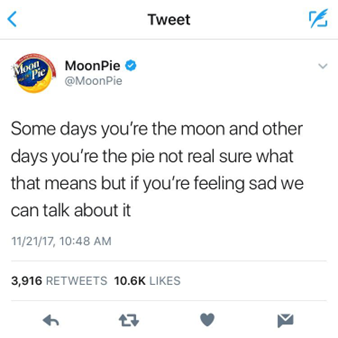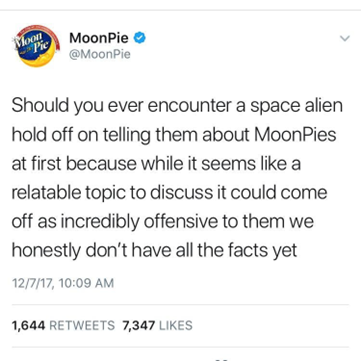Do You Think You’re Funny? Try Being Clever Instead and Watch Your Customers Fall in Love With Your Brand
Relevant topics Archive, Advertising
What is the absolute dream of a brand struggling with a dwindling consumer base? Waking up to find out their demand has suddenly gone through the roof and the biggest problem is not being able to keep up with production!
That’s what happened to the confectionary brand MoonPie when they changed marketing tactics in 2017. Was it their product? Their distribution or sales promotion that they’ve changed?
No, they simply got funny! Smart and funny to be precise, and they laughed all the way to the bank (actually, to customers’ wallets). They adopted a cleverly humorous brand personality on Twitter, and proved how you can successfully and positively influence your brand perception and ultimately, the bottom line.

It’s not only MoonPie who demonstrated the effectiveness of clever humor in advertising and social media branding. In a series of five research studies, the team at Duke University found that:
- Across 40000 posts from brands such as Netflix, Hulu, Moonpie, and Little Debbie, a sample of 1350 users have retweeted and replied the most to cleverly humorous tweets.
- 500 participants had a more positive brand attitude toward food delivery brand Postmates when asked to compare two ads: a cleverly funny ad (“When you want ramen instantly, but not instant ramen”) and a purely funny one (“You're too old for instant ramen”). Both the clever and funny text were superimposed on the same picture of restaurant-quality ramen. The cleverly funny version was rated higher on the cleverness 7-point scale (from unappealing to likable, 7 being extremely).
Personally, my favorite brand who’s proven success by employing clever marketing is the Dollar Shave Club. Their ads use humor and smart wordplay to convey the brand's value proposition. Watch one of their famous ads where the CEO says "Our blades are f***ing great" to emphasize the quality of the product in a humorous way.
What it takes to being great at clever humor
Would you think there is a difference between being funny and being clever? Actually, there is a wide spectrum associated with comedy (anything intended to elicit humor) (Warren et al., 2021).
‘Tickling makes me laugh’, you may say. Is that comedy?It is, but when crafting advertising messages, you want to aim for a mental type of tickling to raise brand perception. The more mental connections are required to understand a bit of humor, the cleverer the joke is perceived to be.
What does actually qualify as clever humor?
Well, the mental connections the audience can activate when faced with brand messages may take various forms:
- Lexical knowledge (i.e. word play)
- Cultural knowledge (i.e. cultural reference)
- Knowledge of how the world works (i.e. ellipses or ‘dot-dot-dot’ jokes where the consumer fills in the missing information with their own interpretation or imagination).
What happens during these mental connections is an ‘aha moment’ - the holy grail you want to grab with both hands if you’re a brand or a marketeer helping a brand succeed.
It requires the consumer to evaluate two opposite ideas or concepts (shifting from one cognitive schema to another). As humor and cleverness share many features (related to conscious mental activities), it is possible to be clever without being funny - or to be funny without being clever. It all depends on the extent to which consumers access their own pre-existing knowledge to make an interpretation.
"Why did the tomato turn red? Because it saw the salad dressing..."
There is something left unsaid here, isn’t it? How would you make sense of it?
You will fill in the gap with your own interpretation, maybe assuming that the tomato was embarrassed by the dressing, and that's why it turned red. It depends on your thinking pattern, your existing set of beliefs, assumptions and the way you process information in your mind.
The use of the ellipses adds humor by allowing you to participate in the joke and create your own punchline.
You shift here from one mental framework to another, which leads to amusement. It requires mental effort - and some people like it. They think it’s clever! It’s quite niche though, and you must know your audience quite well before you apply this strategy in advertising.
Let’s look also at this witty remark: “Statistics means never having to say you're certain”. It requires both a knowledge of statistics and a knowledge of the quote “Love means never having to say you're sorry” from the movie Love Story. Let’s be honest, unless you’re into statistical methods and ‘70s movies all at once, you won’t get the joke.
You can go even further, adopting different comic styles, such as ironic, teasing, dirty, or self-deprecating (with some caution, noted below). They still work as long as you require the consumer to flex their brain muscles and make mental connections between two separate concepts.
The more a consumer feels like they made a mental connection to understand a joke, the cleverer the joke becomes. Your humorous message can bring in the best return when it allows your audience to reach the “aha moment”.
Why clever humor works
Two main reasons for brands to consider when choosing a clever humor strategy both in advertising and social media tone:
- The brand will be seen as smart and competent enough to come up with a funny yet challenging joke.
- Consumers feel closer to a brand that makes humorous references that not everyone understands. They feel special getting a smart joke. They feel your brand has warmth because you talk their language, you understand and share their system of beliefs and attitudes.
Equally as important, the right audience for a brand choosing the clever humor strategy will be made up of people who enjoy playing with mental puzzles and have the required knowledge to refer to in order to solve the puzzle. If they don’t, they won’t think of the brand as smart - so make sure you’re also funny, not just clever. General humor has been proven to have no effect on brand perception.
How brands make customers fall in love with their witty jokes
There are many consumer brands that have found just the right ingredients to amass followers and global brand recognition by employing clever humor in their advertising. I’m sure you’re familiar with these ones, already embedded in popular culture, so let’s revisit:
- Snickers - Everyone knows the "You're Not You When You're Hungry" campaign (most of us disliked it at some point, but probably because we didn’t share the same cognitive schema?). The fact remains it used clever wordplay and humor to convey their message successfully. Remember the football player who turns into a "diva" when he's hungry, with the tagline "You're not you when you're hungry. Snickers satisfies." That’s a clever wordplay!
- Geico - The "15 Minutes Could Save You 15% Or More On Car Insurance" campaign used humorous situations and clever wordplay to make their ads memorable. One ad featured a group of cavemen who were offended by the slogan "So easy, a caveman could do it," highlighting the absurdity of the claim. (It would be offensive if cavemen were still around!)
- Apple - The "Get a Mac" campaign used cultural references to create a humorous comparison between Macs and PCs. The ads featured two actors playing a Mac and a PC. The Mac character was portrayed as cool and hip, while the PC character was portrayed as outdated and uncool. It tapped into the cultural trend of being cool and cutting-edge. It positioned the Mac as the ultimate cool product. (We know already how good Apple is at marketing, no surprises here.)
- Doritos - The "Crash the Super Bowl" campaign invited people to create their own Doritos ads and submit them for a chance to air during the Super Bowl. The campaign tapped into the cultural trend of user-generated content. It allowed people to create their own humorous cultural references that resonated with their peers.
Caution - Not all humor is the same
- The Duke University researchers were able to demonstrate that - clever humor is not for every brand or situation.
- Clever humor may work better for competent or sophisticated brand personalities but not rugged or exciting personalities.
- The effect weakens when the audience doesn’t share the understanding needed to get the joke.
- Offensive jokes and not being aware of cultural differences will backfire. Big brands are known to have gone terribly wrong with their marketing (and ultimately sales revenue) by not being aware of cultural differences(When Chevrolet had trouble selling their 'Novas' models in Mexico, they failed to understand that 'No Va' in Spanish means 'does not go'.)
- Nonsense humor cannot be clever (Ruch et al., 2018) as it’s difficult to strike a balance between funny and confusing or off-putting. (Remember the Skittles' "Touch the Rainbow" campaign that featured a series of bizarre, surreal situations and strange characters. Or Burger King's "Subservient Chicken" campaign where users could enter commands on a website to a person dressed in a chicken costume. They were both confusing and not on brand.
Take Home Points
Clever humor can work well for B2C, but is not a bullet-proof marketing strategy. While it applies to advertising and social media marketing, it hasn’t been proven to be successful with other marketing channels or branding tools.
Clever humor is great at boosting attention and social sharing, making it easier for people to relate to a brand and increase its trust factor. It can even increase the brand recall factor (Badli & Dzulkifli, 2013).
The disadvantages lie in the way clever humor is used: it will not work if it’s offensive to certain groups of people; if it tackles sensitive or tabu social topics among audience segments; if it’s not genuine in intent; or if the jokes don’t consider the timing or external environment of the campaign.
Further Reading
-
“They deserve it, right?” Using other-benefit advertising frames to boost sales of sustainable products
Remember that one time you went out shopping for a coat and came back with a coat and a pair of new shoes?
You definitely experienced some impulsive buying behavior there! Impulsive purchases are by definition unplanned and make you want the product immediately. These impulsive purchases are often evoked by advertisements – especially in the case of more hedonic products that stimulate immediate joy. In this blog, you will learn a simple copywriting technique that allows companies to promote this impulse buying and how sustainability-driven companies can implement this principle to strengthen their competitive position.


